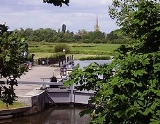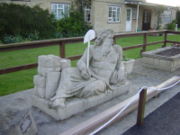
St John's Lock
Encyclopedia
St John's Lock is a lock
on the upper reaches of the River Thames
in England, near the town of Lechlade
, Gloucestershire
. It is the highest lock on the river. It is named after a priory
that was established nearby in 1250, which no longer exists. The lock was built of stone in 1790 by the Thames Navigation Commission
.
The main weir is downstream, just below St. John's Bridge, where the River Cole
and the River Leach
join the Thames on opposite banks.
There is a statue of Old Father Thames outside the lock house. It was commissioned in 1854 for The Crystal Palace
's grounds. It was later moved to the traditional source of the Thames at Thames Head
before being relocated to St John's Lock.
upstream in November 1789. It was built by J. Nock in 1790 and in its early days complaints were made of tolls being evaded by bullying bargemen. The first lock house was built in 1830, the lock-keeper being required to give up residence at the Trout Inn in accordance with Commission's rule that lock-keepers should not be publicans. The lock was reported to be in a poor state by 1857 and in 1867 was repaired. In 1905 the lock was rebuilt and new lock-keeper's bungalow built on the other side of the lock.
.
 The river winds for three quarters of a mile to Lechlade, where it passes under Halfpenny Bridge
The river winds for three quarters of a mile to Lechlade, where it passes under Halfpenny Bridge
(or Ha'penny Bridge), which is so named because it was once a toll bridge. Half a mile after Lechlade there is a connection to the former Thames and Severn Canal
, which linked the Thames to the River Severn
via the Stroudwater Navigation
and the Gloucester and Sharpness Canal
. The Thames and Severn Canal is the subject of a restoration plan, and so navigation beyond Lechlade may one day be possible again. The River Coln also joins the Thames at the canal junction, where there is sufficient room to wind a 70 ft narrowboat with care. There are no more locks upstream on the River Thames, with Lechlade normally considered to be the end of the navigable river, but there is a right of navigation as far as Cricklade
, and small craft may be able to travel for a further three miles beyond Lechlade when there is plenty of water in the river.
The Thames Path
continues along the southern bank past Lechlade to Inglesham and next crosses the river at Water Eaton House Bridge
.
Lock (water transport)
A lock is a device for raising and lowering boats between stretches of water of different levels on river and canal waterways. The distinguishing feature of a lock is a fixed chamber in which the water level can be varied; whereas in a caisson lock, a boat lift, or on a canal inclined plane, it is...
on the upper reaches of the River Thames
River Thames
The River Thames flows through southern England. It is the longest river entirely in England and the second longest in the United Kingdom. While it is best known because its lower reaches flow through central London, the river flows alongside several other towns and cities, including Oxford,...
in England, near the town of Lechlade
Lechlade
Lechlade, or Lechlade-on-Thames, is a town at the southern edge of the Cotswolds in Gloucestershire, England. It is the highest point at which the River Thames is navigable. The town is named after the River Leach that joins the Thames near here....
, Gloucestershire
Gloucestershire
Gloucestershire is a county in South West England. The county comprises part of the Cotswold Hills, part of the flat fertile valley of the River Severn, and the entire Forest of Dean....
. It is the highest lock on the river. It is named after a priory
Priory
A priory is a house of men or women under religious vows that is headed by a prior or prioress. Priories may be houses of mendicant friars or religious sisters , or monasteries of monks or nuns .The Benedictines and their offshoots , the Premonstratensians, and the...
that was established nearby in 1250, which no longer exists. The lock was built of stone in 1790 by the Thames Navigation Commission
Thames Navigation Commission
The Thames Navigation Commission used to manage the River Thames in southern England. In particular, they were responsible for installing or renovating many of the locks on the river in the 18th and early 19th centuries.- History :...
.
The main weir is downstream, just below St. John's Bridge, where the River Cole
River Cole
The River Cole may refer to:*The River Cole, West Midlands, England, which flows directly through Birmingham*The River Cole, Wiltshire, England, which flows through Wiltshire and Oxfordshire, where it forms the border...
and the River Leach
River Leach
The River Leach is a river tributary to the River Thames, in England which runs mostly in Gloucestershire. It is approximately 18 miles long, springing from the limestone uplands of the Cotswolds. In parts of its course it becomes a seasonal bourn, only running above ground when there is...
join the Thames on opposite banks.
There is a statue of Old Father Thames outside the lock house. It was commissioned in 1854 for The Crystal Palace
The Crystal Palace
The Crystal Palace was a cast-iron and glass building originally erected in Hyde Park, London, England, to house the Great Exhibition of 1851. More than 14,000 exhibitors from around the world gathered in the Palace's of exhibition space to display examples of the latest technology developed in...
's grounds. It was later moved to the traditional source of the Thames at Thames Head
Thames Head
Thames Head is a site in Gloucestershire, traditionally identified as the source of the River Thames, a major river which runs through the centre of London. It lies near the village of Kemble and the town of Cirencester....
before being relocated to St John's Lock.
History
The need for a pound lock here arose as a result of the opening of the Thames and Severn CanalThames and Severn Canal
The Thames and Severn Canal is a canal in Gloucestershire in the south of England, which was completed in 1789. It was conceived as part of a canal route from Bristol to London. At its eastern end, it connects to the River Thames at Inglesham Lock near Lechlade, while at its western end, it...
upstream in November 1789. It was built by J. Nock in 1790 and in its early days complaints were made of tolls being evaded by bullying bargemen. The first lock house was built in 1830, the lock-keeper being required to give up residence at the Trout Inn in accordance with Commission's rule that lock-keepers should not be publicans. The lock was reported to be in a poor state by 1857 and in 1867 was repaired. In 1905 the lock was rebuilt and new lock-keeper's bungalow built on the other side of the lock.
Access to the lock
The lock can be reached easily from St John's Bridge which is about a mile out of Lechlade on the A417 roadA417 road
-Streatley - Gloucester :It runs from Streatley at its junction with the A329 to Wantage, over the picturesque Berkshire Downs. In Wantage, it negotiates the market place -Streatley - Gloucester (M5):It runs from Streatley at its junction with the A329 (between Reading and Wallingford) to Wantage,...
.
Reach above the lock

Halfpenny Bridge
Halfpenny Bridge is a bridge across the River Thames, at Lechlade, Gloucestershire, England. It marks the start of the navigable Thames.The bow-backed bridge was built to a design of James Hollingworth in 1792. It carries the A361 from the south into Lechlade...
(or Ha'penny Bridge), which is so named because it was once a toll bridge. Half a mile after Lechlade there is a connection to the former Thames and Severn Canal
Thames and Severn Canal
The Thames and Severn Canal is a canal in Gloucestershire in the south of England, which was completed in 1789. It was conceived as part of a canal route from Bristol to London. At its eastern end, it connects to the River Thames at Inglesham Lock near Lechlade, while at its western end, it...
, which linked the Thames to the River Severn
River Severn
The River Severn is the longest river in Great Britain, at about , but the second longest on the British Isles, behind the River Shannon. It rises at an altitude of on Plynlimon, Ceredigion near Llanidloes, Powys, in the Cambrian Mountains of mid Wales...
via the Stroudwater Navigation
Stroudwater Navigation
The Stroudwater Navigation is a canal linking Stroud to the Severn Estuary in England and Wales. It was authorised in 1776, although part had already been built, as the Proprietors thought that an Act of Parliament obtained in 1730 gave them the necessary powers. It opened in 1779, and was a...
and the Gloucester and Sharpness Canal
Gloucester and Sharpness Canal
The Gloucester and Sharpness Canal or Gloucester and Berkeley Canal is a canal in the west of England, between Gloucester and Sharpness; for much of its length it runs close to the tidal River Severn, but cuts off a significant loop in the river, at a once-dangerous bend near Arlingham...
. The Thames and Severn Canal is the subject of a restoration plan, and so navigation beyond Lechlade may one day be possible again. The River Coln also joins the Thames at the canal junction, where there is sufficient room to wind a 70 ft narrowboat with care. There are no more locks upstream on the River Thames, with Lechlade normally considered to be the end of the navigable river, but there is a right of navigation as far as Cricklade
Cricklade
Cricklade is a town and civil parish on the River Thames in north Wiltshire in England, midway between Swindon and Cirencester.On 25 September 2011 Cricklade was awarded The Royal Horticultural Society's 'Champion of Champions' award in the Britain in Bloom competition.Cricklade is twinned with...
, and small craft may be able to travel for a further three miles beyond Lechlade when there is plenty of water in the river.
The Thames Path
Thames Path
The Thames Path is a National Trail, opened in 1996, following the length of the River Thames from its source near Kemble in Gloucestershire to the Thames Barrier at Charlton. It is about long....
continues along the southern bank past Lechlade to Inglesham and next crosses the river at Water Eaton House Bridge
Water Eaton House Bridge
Water Eaton House Bridge is a footbridge across the River Thames in Wiltshire, England. It is situated between Cricklade and Castle Eaton near Water Eaton House. It is one of the first bridges on the Thames Path....
.

